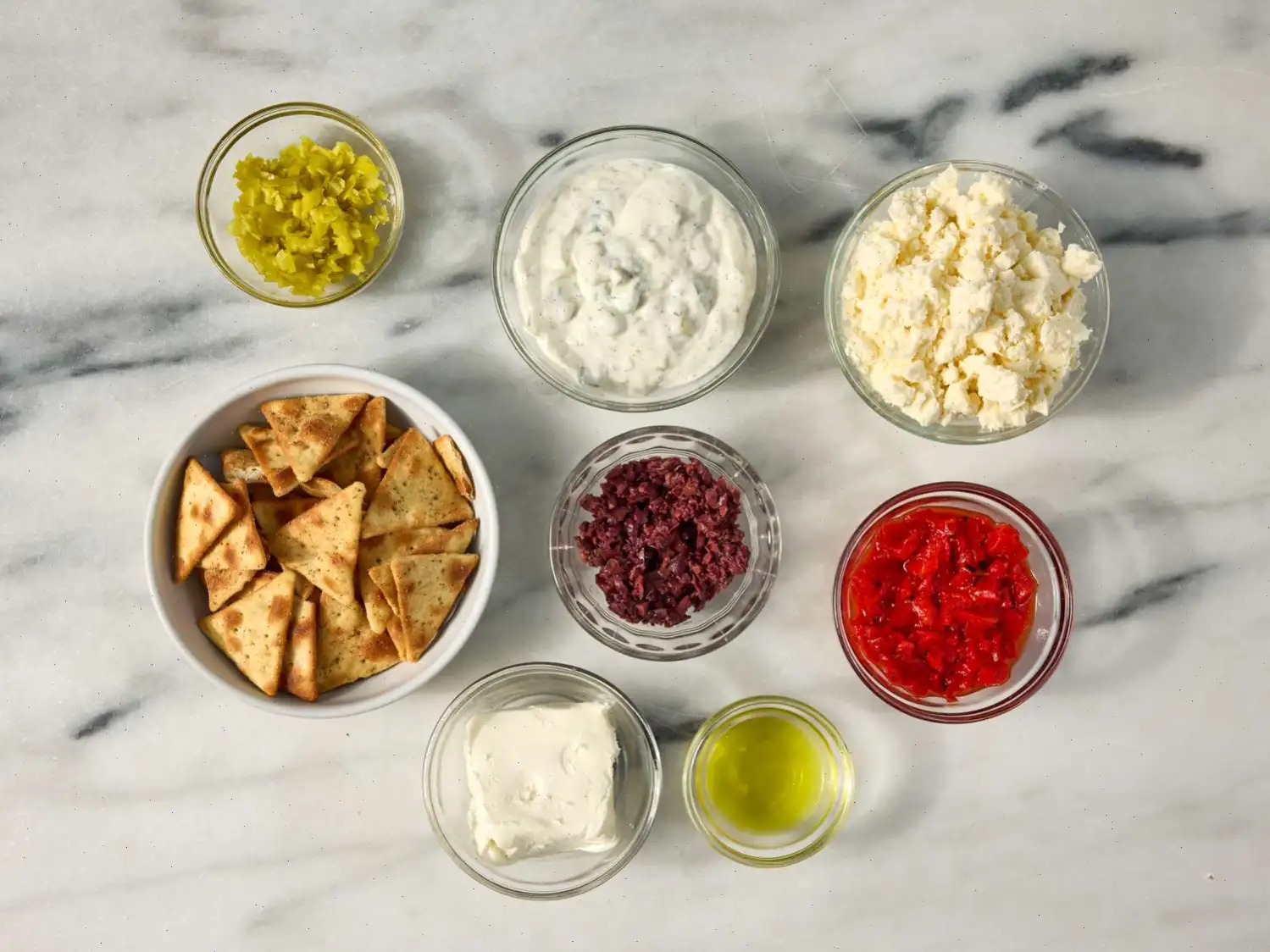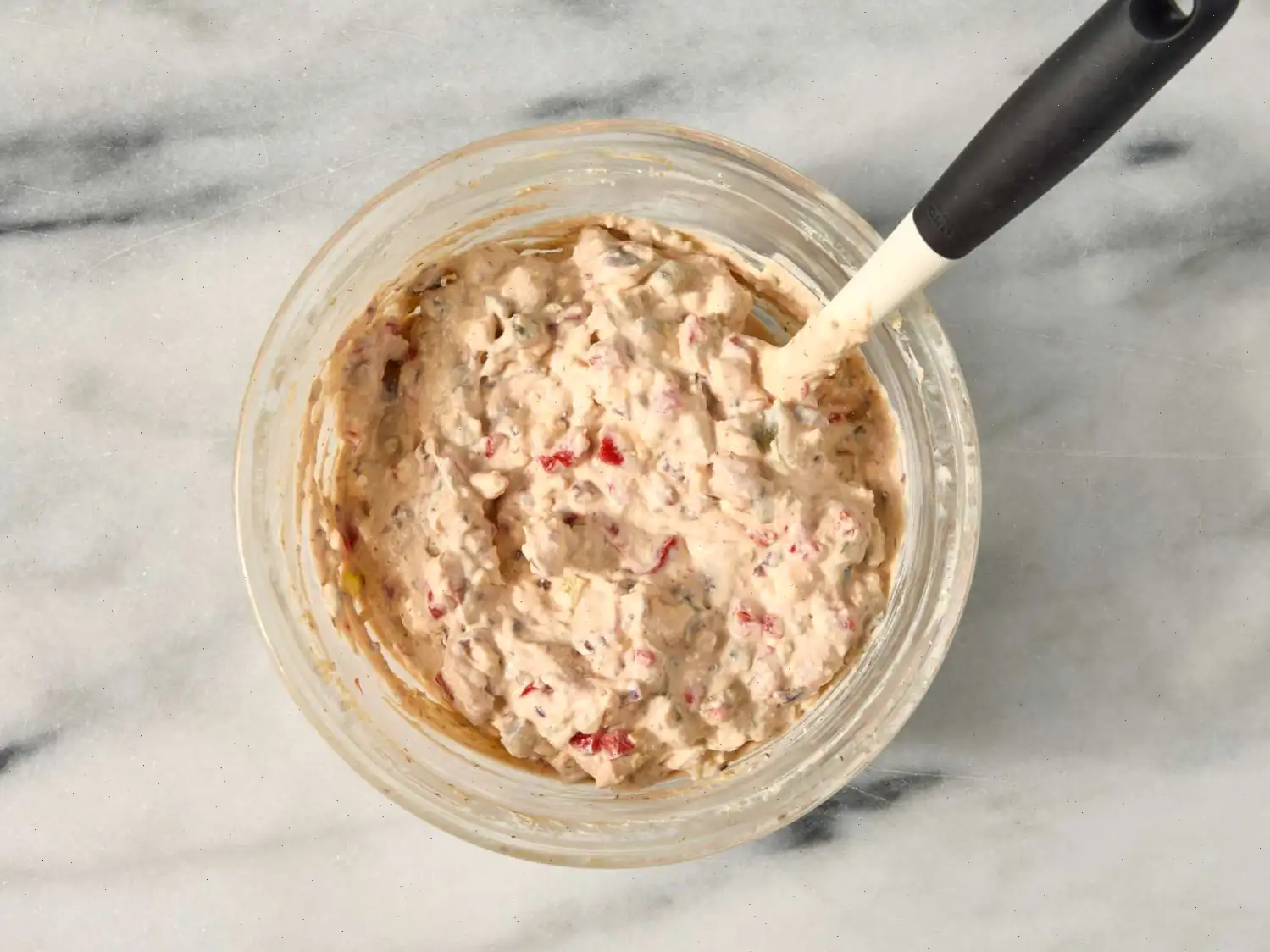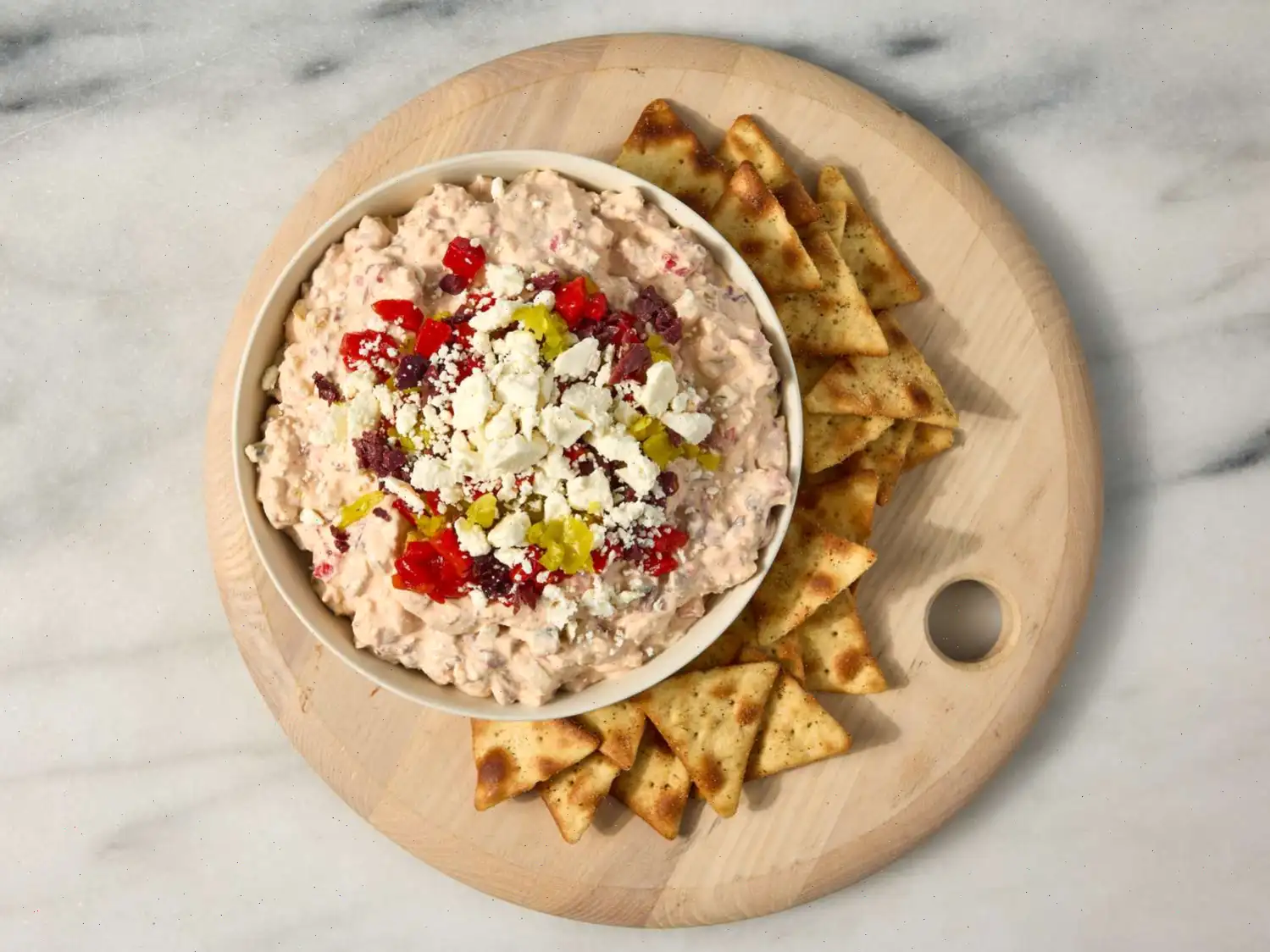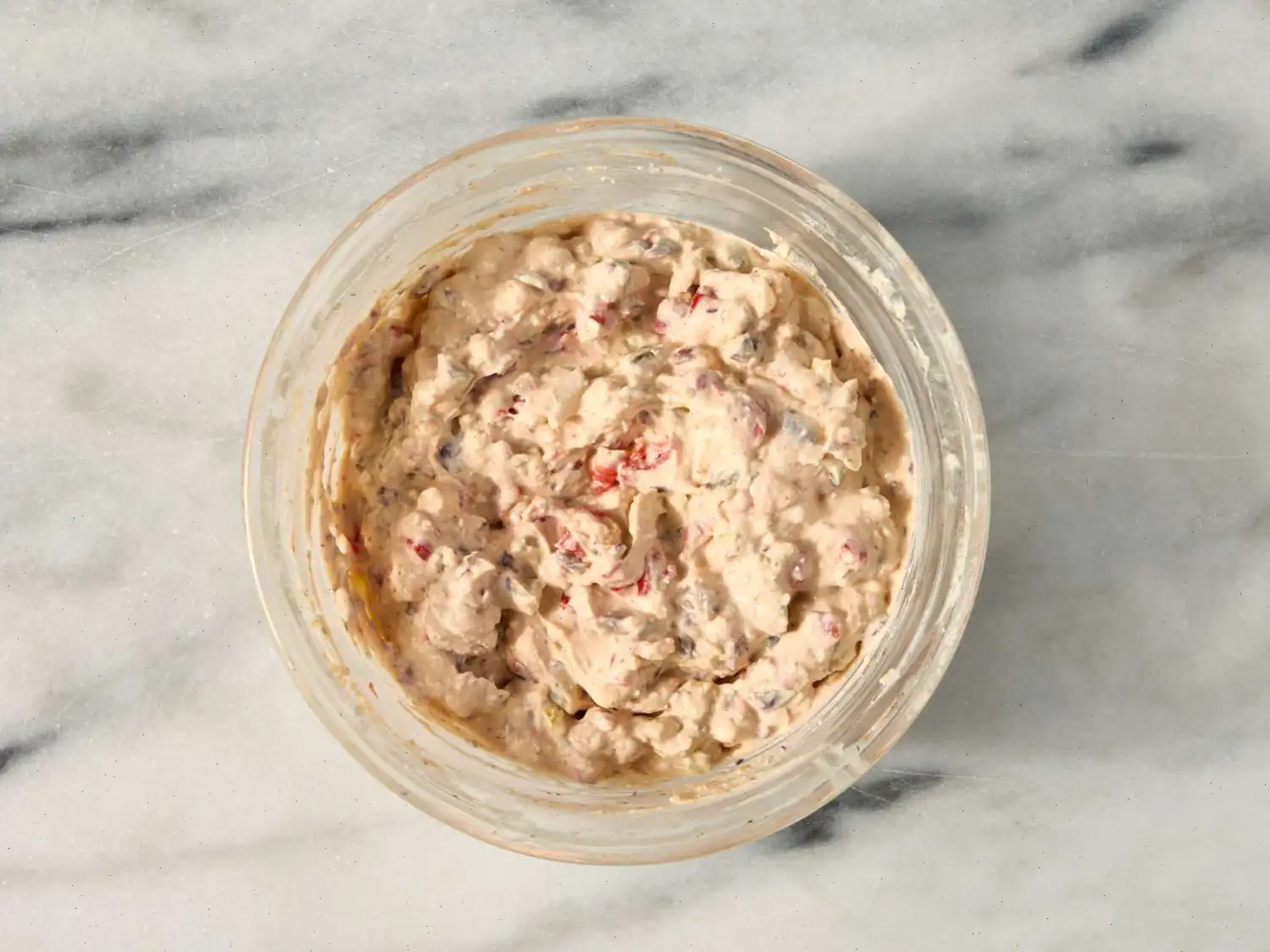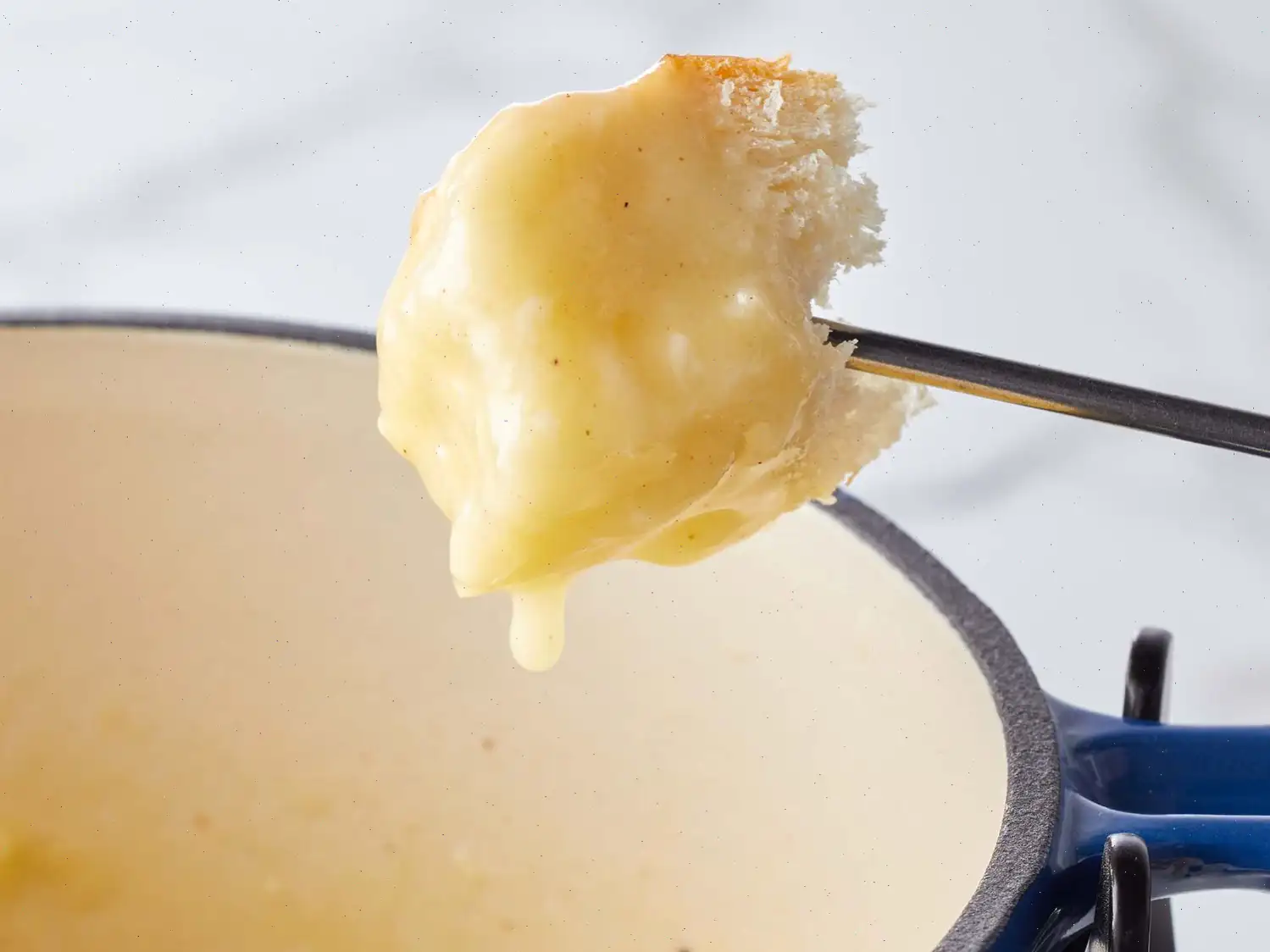
Chopped Greek Salad Dip Recipe
Ingredients
- 4 ounces cream cheese, softened
- 1 (8 ounce) block feta cheese, crumbled, divided
- 3 tablespoons pickled pepperoncini brine
- 1/3 cup drained sliced pickled pepperoncini, finely chopped, plus more for garnish
- 3/4 cup prepared tzatziki
- 1/2 cup jarred roasted red bell peppers, drained, patted dry, and finely chopped, plus more for garnish
- 1/3 cup sliced kalamata olives, finely chopped, plus more for garnish
- Pita chips, for serving
Directions
- Gather all the ingredients to make sure everything is ready for preparation.
- Combine the cream cheese and 1 cup of crumbled feta in a food processor. Process for about 1 minute, or until the mixture becomes mostly smooth, stopping to scrape down the sides if needed.
- With the food processor running, slowly drizzle in the pickled pepperoncini brine through the chute. Continue processing for about 2 minutes, until a smooth, whipped dip forms.
- Transfer the feta mixture to a large bowl. Fold in the chopped pickled pepperoncini, tzatziki, roasted red bell peppers, olives, and 3/4 cup of the remaining feta until everything is evenly combined.
- Cover the bowl and chill the mixture in the fridge for about 1 hour, until it thickens and becomes cold.
- Before serving, garnish the dip with additional chopped pepperoncini, red bell peppers, olives, and the remaining 1/4 cup of crumbled feta.
- Serve with pita chips on the side.
Nutrition Facts (per serving)
| Calories | 210 |
|---|---|
| Total Fat | 17g (21% Daily Value) |
| Saturated Fat | 9g (46% Daily Value) |
| Cholesterol | 49mg (16% Daily Value) |
| Sodium | 858mg (37% Daily Value) |
| Total Carbohydrates | 9g (3% Daily Value) |
| Dietary Fiber | 1g (3% Daily Value) |
| Total Sugars | 5g |
| Protein | 7g (15% Daily Value) |
| Vitamin C | 28mg (31% Daily Value) |
| Calcium | 225mg (17% Daily Value) |
| Iron | 1mg (4% Daily Value) |
| Potassium | 129mg (3% Daily Value) |

Description: This chopped Greek salad dip is a vibrant, tangy, and creamy appetizer bursting with Mediterranean flavors. It combines ingredients like feta, tzatziki, roasted red peppers, pepperoncini, and olives, making it the perfect dip for pita chips or fresh vegetables.
History of Origin
The Greek Salad Dip is inspired by the traditional Greek salad, a staple dish in Greek cuisine that dates back to ancient times. The classic Greek salad, or "Horiatiki," consists of tomatoes, cucumbers, onions, olives, and feta cheese, often seasoned with olive oil, salt, and oregano. The modern interpretation of a Greek salad dip takes these traditional ingredients and adapts them into a creamy, indulgent dip format that has become popular in various parts of the world. While its exact origin as a dip is unclear, it is often served as a contemporary variation in Mediterranean-inspired parties, gatherings, or appetizers in the U.S. and Europe.
Regional Features
In Greece, the basic elements of a Greek salad are widespread throughout the country, with some variations in the use of vegetables or herbs. The chopped Greek salad dip, however, takes on a more universal appeal, seen not just in Greece but in many countries influenced by Mediterranean cuisine. The inclusion of tzatziki, a yogurt-based cucumber dip, is particularly common in Eastern Mediterranean and Balkan regions, adding a refreshing note to the dip. Roasted red peppers, which are often used in many Mediterranean dishes, bring a smoky sweetness to the dip, adding to its complexity.
Differences from Similar Dishes
While the Greek salad dip shares similarities with other Mediterranean dips like hummus, baba ganoush, or tzatziki, it stands out because it combines the flavors of a Greek salad in a creamy format. Unlike hummus, which is chickpea-based, or baba ganoush, which is made with eggplant, the Greek salad dip incorporates dairy, primarily from the feta cheese and cream cheese. Additionally, it features the briny tang of pickled pepperoncini and kalamata olives, which are key ingredients that distinguish it from other dips in Mediterranean cuisine. The use of tzatziki in this dip also makes it creamier compared to a traditional Greek salad, which tends to be drier and more refreshing.
Where It Is Typically Served
This dip is a favorite at Mediterranean-themed parties, potlucks, and casual gatherings, often served as an appetizer or snack. It's a great choice for serving with pita chips, crackers, or fresh vegetables like cucumbers, carrots, and celery. Given its rich and tangy flavors, its also a popular option at festive gatherings such as Greek Easter, summer barbecues, and Mediterranean feasts. Restaurants serving Mediterranean or Greek-inspired dishes may offer this dip as a creative twist on the classic Greek salad, providing a delicious starter for their patrons.
Interesting Facts
- Feta cheese, a key ingredient in this dip, has been made in Greece for thousands of years and is considered one of the oldest cheeses in the world.
- The pepperoncini used in the dip brings a mild, tangy flavor that adds an unexpected kick, making the dip more complex and exciting to the palate.
- Tzatziki, another important component, is traditionally made with Greek yogurt, cucumbers, garlic, olive oil, and herbs. Its known for its cooling properties, making it ideal for hot summer days.
- Greek salads, on which this dip is based, have been enjoyed since ancient times and were likely consumed by the ancient Greeks as a simple, healthy meal using readily available ingredients.
- While this dip may have originated as a modern adaptation of the Greek salad, its popularity has spread globally, with people all over the world experimenting with the ingredients and making variations of the recipe.
FAQ about Chopped Greek Salad Dip Recipe
Comments
Samuel Robinson
10/20/2024 05:56:23 AM
Costly to prepare, but absolutely delicious and unique compared to typical dips. I paired it with pita chips, cucumbers, and carrots as dippers. I will definitely make it again following the exact recipe.



